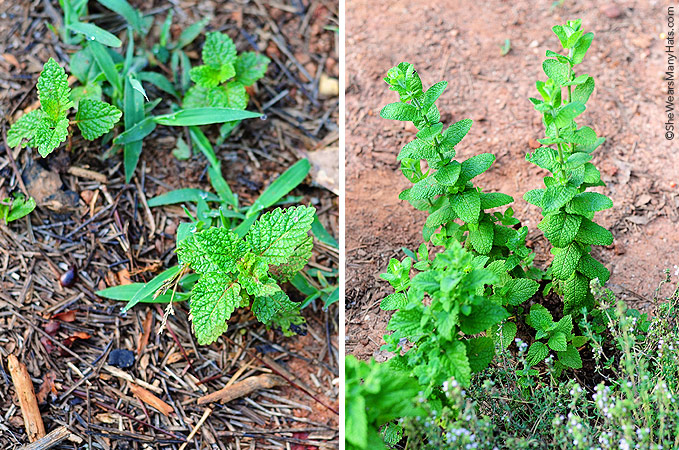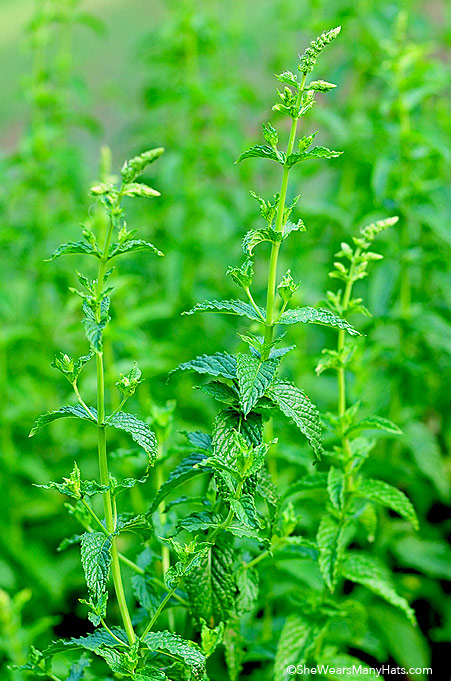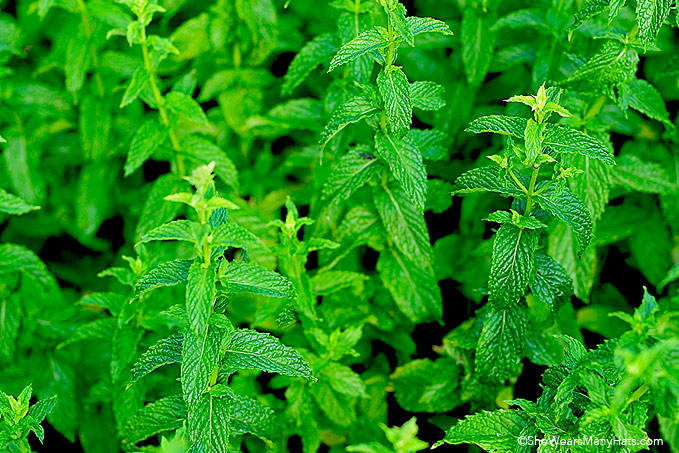Tips for Growing Mint
This post may contain Amazon or other affiliate links. As an Amazon Associate I earn from qualifying purchases.
Helpful tips for growing mint in your own garden.
Mint can hold it’s own in the culinary world, deservedly so. Just imagine no mint juleps or mint chocolate chip ice cream. That would be very sad. Very sad, indeed.
Growing mint in your garden is easy to do, although mint can be quite the booger, sending out runners underground to resurface yards away. Of all herbs in the garden, mint (along with Lemon Balm) is one of the hardiest, most prolific, aggressive overachiever of the bunch. It can be quite the pain if not planted correctly. I’ve pulled up yards and yards of mint rooster the years.
Here are a few areas it’s popped up several feet away from where it was originally planted.
Don’t let this be a discouragement from growing some of your own. There are ways to grow this helpful, tasty herb and not have it take over your whole neighborhood, so you can have a supply of mint ready at hand for that next batch of mint jelly. Unfortunately, I learned these tips the hard way, after it was already planted, thriving, and way out of control. So, please, learn from my mistakes.
The easiest way is to plant mint to control the spreading is to plant it in a large container with drainage holes that are covered with mesh, so it can drain but keep the roots from sneaking through the hole and overtaking the county.
Another way to manage the mint is to dig a hole the size you want your mint patch to be, about a foot or so deep, then line it with landscaping fabric, refill with soil, then plant the mint. Be sure to watch for feelers as they could still creep over the top edge of the landscape fabric, escaping the set boundary. Mint is sneaky, y’all.
When deciding on the perfect patch for the mint, look for well drained soil, but not too dry. Mint likes moisture and is happiest in partial shade. Certain varieties can handle full sun better than others. Too much shade will result in leggy mint. Which will still taste wonderful, but may not produce as many leaves as you’d like.
Tips for growing mint:
- Mint prefers partial shade. Full sun will do, but part shade is best.
- Choose a spot with moist but well drained soil. Mint prefers fertile soil with a pH from 6.0 to 7.0.
- Plant mint seedlings after frost about 18-24 inches apart.
- Mint can be grown from seed, plants, or even one of the fastidious runners/roots.
- Harvest tips regularly to keep plants in check and encourage best growth.
- For the best flavored mint with a strong scent, transplant your mint every 3-4 years.
There are many varieties of mint to choose from as well. Check out these varieties (information gleaned from Clemson Extension):
- Spearmint (Mentha spicata) is one of the easiest varieties to grow, and is the variety usually used in mint juleps and teas.
- Peppermint (Mentha x piperita) is what you grow for that candy cane flavor.
- Ginger mint (Mentha x gentilis)
- Applemint (Mentha rotundifolia)
- Pineapple mint ( Mentha suaveolens ‘Variegata’)
- Corsican mint (Mentha corsica) is a dwarf variety.
Of course, I know where you can get some on the cheap – free even! I have this friend who is a mint farmer, and she…oh, who am I fooling. If you are ever in the area, I’d be happy to share some IF you promise to plant it in a container.
Originally posted June 7, 2011. Updated June 2, 2015.







I picked this year….the year with NO RAIN to pull everything out of our flower beds and re-plant. you know what’s doing the best? The ,mint that I planted as a “filler.” As a matter of fact, I think it might “fill” the entire bed. 😉
I planted some chocolate mint and it smells wonderful. I just don’t have a clue what to do with it.
I love mint. I planted some in a planter this year, but its pretty small. My neighbor has some in their yard and it has grown out of control. Its fine with me as I have all the mint I want for mojitos!
Would you believe I have a hard time keeping mint alive? I’ve tried putting it in a pot and in a flowerbed with some other herbs. It either dies or is very weak looking with tiny leaves. I kind of have a brown thumb so may that’s why….
Lovely mint and it smells delicious, too! I love your site!
Stunning photos! I need to grow some mint…pronto!
My hubby wont let me plant mint in the ground anymore. 🙁 It has to be in a pot. LOL
Like so many others, I made the mistake of planting it in the ground and soon became overwhelmed. Large pots are definitely the way forward!
Looks like this is the herb for me, though my basil seems to be thriving. It’s a miracle! I have a black thumb. Wonder if mint grown by me could be quite as sneaky, her hee.
I have a mint in the front of my apartment and lemon balm. But, I’m not sure what type of mint it is. I would like to dig it both of up and plant then in a pot to bring them into my apartment. And how can I tell what kind of mint it is that is growing infront of my apartment.
Hope springs eternal! ???? Thanks for the tips.